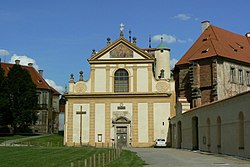Plasy Monastery
| Plasy Monastery | |
|---|---|
 Monastery church |
|
| location |
|
| Coordinates: | 49 ° 56 '4 " N , 13 ° 23' 27" E |
| founding year | 1146 |
| Year of dissolution / annulment |
1785 |
| Mother monastery | Langheim Abbey |
| Primary Abbey | Morimond Monastery |
The Plasy Monastery (German Plaß) is a former Cistercian monastery in Plasy in the Pilsen-Nord district in the Czech Republic and a national cultural monument .
history
The Cistercian monastery was founded in 1146 by Vladislav II as a subsidiary of Langheim Monastery in Upper Franconia from the filiation of the Morimond Primary Abbey . In 1531 the monastery was burned down by army groups of the Hussites after the battle of Taus under the general Andreas Prokop the Great , but remained as a monastery.
The monastery complex was expanded and rebuilt several times. Extensive renovations took place between 1685 and 1740 and were led by Jean Baptiste Mathey , Jan Blažej Santini-Aichel and Kilian Ignaz Dientzenhofer .
The Baroque architecture was complemented by frescoes by FA Müller, JA Pink and Josef Kramolín in the chapels and in the corridors of the first floor . From 1826 to 1945 the building was owned by the Metternich Princely House, who had it converted into a residence. The final resting place of Prince Klemens Wenzel Lothar von Metternich is in the St. Wenceslas Church with the adjoining old cemetery in Plasy .
A provost house with the pilgrimage church Mariánská Týnice belonged to the manorial estate of the monastery . The Cistercians operated a mill and a sawmill using the water from the royal gallery , as a canal was called.
Under Joseph II , the monastery was dissolved in favor of a religious fund and sold in 1826 to the Metternich princes, who had it rebuilt and promoted the associated large estates, especially the forest areas, in their economic income through progressive economics. Until 1918 the property belonged to the Austro-Hungarian monarchy .
During the period of socialism in Czechoslovakia , the building of the former Plasy monastery was used for various purposes and fell into disrepair. In the 1960s, in response to the border strip with Bavaria known as the Iron Curtain , a shelter for civil defense was installed in the cellar under the prelature . The old baroque cellar was destroyed.
Restoration of the buildings began in 1993 and the monastery was declared a national cultural monument in 1995. The building of the prelature was made available by the monument office for a museum of technology. In 2015, the National Technical Museum set up a museum for the history of architecture .
The Stretti family's collection of paintings is on display in the monastery .
Buildings and plant
The later Baroque-style monastery church goes back to a Romanesque building, which the Olomouc bishop Robert consecrated in 1204 and whose layout (three-aisled nave, with the side aisles separated by Pfelner, transept and presbytery with semicircular closed apse ) is still recognizable in the existing building. The lack of transept chapels is striking. There are no more remains of the cloister that originally adjoined it to the south . The nave was extended to the east in the 13th century. The monastery area was rebuilt until 1628. To the north-east of the end of the choir stands the Gothic two-story royal chapel, which emerges from the baroque granary; her ground floor is dedicated to St. Wenceslas , while the much higher floor is dedicated to St. Mary Magdalene; here there are chalice-shaped service capitals.
A square tower integrated into a farm building still stands from the medieval enclosure of the monastery.
people
- In 1996 the light artist Claudia Wissmann realized her installation Night Falls - Light Falls for the inner courtyard of the monastery.
Individual evidence
- ↑ a b c d Bunker under the prelature: Cistercian monastery Plasy on Radio Prague from October 2, 2010, accessed on October 2, 2010.
- ↑ Night Falls-Light Falls. In: Claudia Wissmann: Reality and its cadrage. Ardey-Verlag, Münster 1999, ISBN 3-87023-117-3 , pp. 16-18.
literature
- Jiři Kuthan: The medieval architecture of the Cistercians in Bohemia and Moravia. Deutscher Kunstverlag, Munich / Berlin 1982, ISBN 3-422-00738-5 , pp. 122–135.
- Emanuel Poche: Art Monuments in Czechoslovakia: Bohemia and Moravia. Deutscher Kunstverlag, Munich / Berlin 1986, ISBN 3-422-00377-0 , pp. 430–432.
- Kateřina Charvátová, Dobroslav Líbal: Plasy. In: Daniela Houšková (ed.): Řád cisterciáků v českých zemích ve středověku - Sborník vydaný k 850. výročí založení kláštera v Plasech. Unicornis, Praha 1994, ISBN 80-901587-1-4 , pp. 44-46.
- Lillian Schacherl: Bohemia. Cultural image of a landscape, art landscape of the baroque. Prestel Verlag, Munich 1966, p. 118 f.
- Bernard Peugniez : Le Guide Routier de l'Europe Cistercienne . Editions du Signe, Strasbourg 2012, p. 1078.
Web links
- Website of the monastery (cz / en)
- Museum of Architectural History Plasy (cz)







